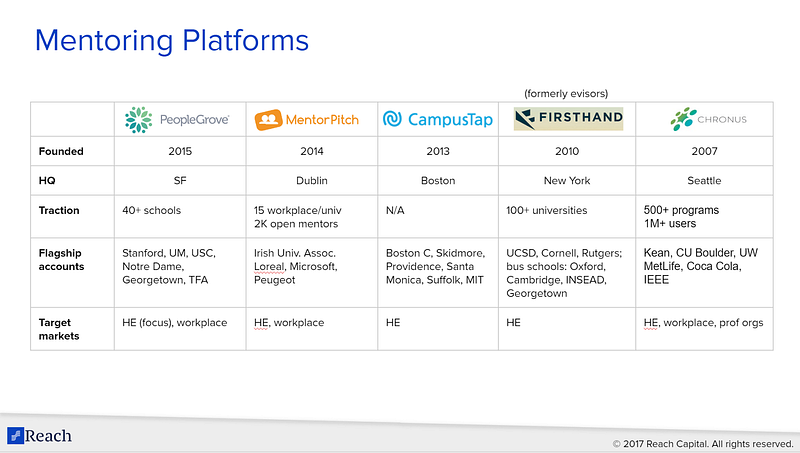
Origins
Reach’s curiosity about college success solutions came through a back door. One of our pre-seed investments, PeopleGrove, had achieved great traction with its online mentoring platform, signing on more than 40 higher ed institutions in less than a year. We wanted to better understand the market demand and competitive landscape.
We were initially drawn to PeopleGrove’s mission because of the potential of online mentoring to build social capital for low-income students with limited networks (Putnam, Freeland Fisher). Higher ed institutions think about mentorship as part of a constellation of supports they provide students to help them successfully navigate to, through and beyond college. We framed the solution set for our market map using this broader context of supporting college success.
Organizing principles
The category of “college success” is crowded with many players and overlapping feature sets. On the surface, while some solutions appear to be competitive, a deeper look might reveal them to be complementary. At the highest level, we categorized solutions into three functions that higher education institutions perform: (1) identifying students who need support, (2) connecting them to services based on those needs, and (3) providing services.

Identifying needs with predictive analytics
Solutions focused on identifying needs pull together student data from various sources — e.g., course enrollment, GPA, LMS activity, or visits to the advising center — and flag students who may be at risk for falling off track using predictive analytics. Products shown in this category are partly differentiated by the types of data that drive their predictive engines.
Connecting students to services
The second category of solutions builds students’ awareness of and connects them to the various student services available across campus. We further subdivide solutions that perform this function by how they facilitate the connections. One subset of solutions creates a directory of campus resources and makes them available through a website or app. Another subset predicts students’ needs and nudges them to take action based on behavioral science.
Providing support services
The third category of solutions is related to the actual delivery of services. We subcategorize these services based on the “lifecycle” phase of students and the types of supports colleges provide to meet their needs during that phase. Once students are on campus, colleges provide supports to help students navigate college and successfully reach graduation with services such as academic advising, tutoring, and mental health and wellness services. As students approach graduation, career centers support students’ transition into the workplace with career advising and recruitment services. After graduation, universities help alumni build networks, stay engaged with their alma mater, and encourage giving.
Note, a lifecycle phase not included in this map is the transition from high school to college. Solutions in this phase include college recruiting and enrollment solutions.

We organize the services map by lifecycle stage (y-axis) and along a spectrum of type of support (x-axis), from transactional to building social capital. An example of a transactional interaction is a student who is struggling on a problem set posting a question on a discussion forum and receiving a tip from a TA. An example of building social capital is a student who has developed a relationship with an alumni mentor who can provide a range of advice from how to find balance in school to exploring potential career paths.
Deep dive on mentoring platforms
Note that there are numerous providers in the college success space and that we only include a sampling of both categories and providers here. Each subcategory, e.g. tutoring or career services — is rich enough to merit its own map. At this time, we take a deeper look at mentoring platforms and compare five leading providers.

Takeaways
Demand drivers
- Financial incentives. While higher ed institutions are motivated to support students for their mission, they are also financially incented. For example, improved student retention equates to more tuition and fees collected, and engaged alums drive giving.
Solutions
- Just in time support. Tech solutions tend to address immediate student needs through transactional relationships and “flash mentorships” — e.g. homework help, resume review, and interview prep. Solutions that strive to build longer-term supportive relationships for students tend to be non-profits.
- Differentiation by purchaser, not feature set. Platforms that target different phases of a student lifecycle have similar feature sets. A platform could easily expand its focus to a different lifecycle phase. For example, a social networking platform for alumni could easily be deployed for current students. The main difference for the platform vendors is the sales target at the higher ed institution.
Use of technology
- Artificial intelligence. AI is making inroads into student support services with analytics solutions ranging from descriptive, to diagnostic, to predictive, to prescriptive.
- Enabling human interactions. In the delivery of student support services, technology serves to connect, not displace people through the use of communication tools, marketplaces, and social network platforms.
*Info on our market maps can be found here.


